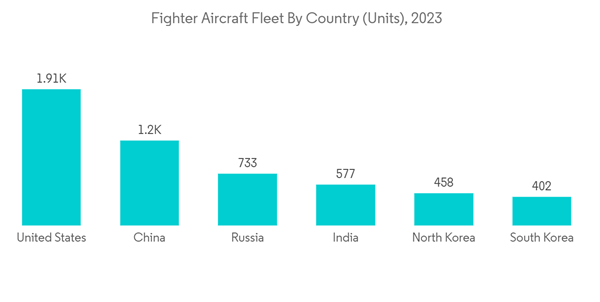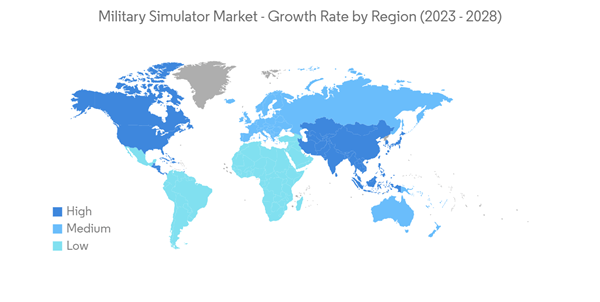The Simulator Market size is estimated at USD 11.54 billion in 2024, and is expected to reach USD 15.78 billion by 2029, growing at a CAGR of 6.45% during the forecast period (2024-2029).
The growth in demand for military vehicles across the land, sea, and aerial platforms is the main driver of the market growth. Several countries are modernizing their military fleets by inducting newer generation vehicle platforms, generating a simultaneous demand for simulation-based training for the military personnel on these platforms, thereby propelling the market prospects of the related military simulators. Furthermore, increasing defense expenditure and rising procurement of military aircraft creates demand for advanced military simulators. According to the Stockholm International Peace Research Institute (SIPRI) report published in 2022, the global defense expenditure reached a record high of USD 2.24 trillion in 2022.
The training of pilots and military personnel in real aircraft, land vehicles, and ships involves many risks and sometimes may lead to hazardous situations and loss of lives. Simulators provide a realistic experience and safety training for beginners. This need for safe and efficient training is also driving the simulator market. Moreover, stringent regulatory approvals and complex licensing procedures for simulators hamper the growth of the market.
Moreover, the increasing adoption of newer aircraft that incorporate complex technologies in the military may require pilots to familiarize themselves with the latest equipment and systems. For instance, in March 2023, the Indian Defense Ministry announced that they had sealed a deal with Hindustan Aeronautics Limited (HAL) to procure 70 HTT-40 basic trainer aircraft at a cost of more than USD 825.67 million for the Indian Air Force. Moreover, the HTT-40 is a turboprop aircraft possessing good low-speed handling qualities and training effectiveness. It is expected to meet the IAF’s shortage of basic trainer aircraft for the training of newly inducted pilots. Furthermore, in February 2023, BAE Systems plc and FSTC announced plans to design, build, and supply simulators to train pilots of the Indian armed forces. As a part of their partnership, both companies will develop a twin-dome full mission simulator for the BAE Systems Hawk 132 jet trainer aircraft, which will use a realistic synthetic environment to help pilots train at a higher standard. Thus, growing procurement of next-generation fighter jets and a rising number of pilot training programs drive the growth of the segment during the forecast period.
Also, the country is investing in the development and procurement of related simulator solutions, which in turn drives market growth across the region. Although the US Air Force has been procuring simulators on a large scale for several years, the US Navy is investing heavily in simulation to improve its navigation training, and it budgeted for new integrated bridge simulators to fill the capacity gaps. The efforts to increase ship simulator capacity are further supported by constructing new buildings in San Diego and Norfolk to house multiple simulation facilities. The Royal Canadian Air Force plans to combine two training programs under a single, multibillion-dollar project, the Future Aircrew Training Program, or FATP, where the number of pilots trained annually will increase.
Furthermore, the government of Canada, with plans to implement fire training simulators for military uses, offered to stand to VirTra, Inc. in December 2021. As per the offer, the company is expected to supply advanced military training simulators to the country’s land, marine, and air force divisions of the military. Such developments are expected to drive the growth of the market in the North American region during the forecast period.
This product will be delivered within 2 business days.
The growth in demand for military vehicles across the land, sea, and aerial platforms is the main driver of the market growth. Several countries are modernizing their military fleets by inducting newer generation vehicle platforms, generating a simultaneous demand for simulation-based training for the military personnel on these platforms, thereby propelling the market prospects of the related military simulators. Furthermore, increasing defense expenditure and rising procurement of military aircraft creates demand for advanced military simulators. According to the Stockholm International Peace Research Institute (SIPRI) report published in 2022, the global defense expenditure reached a record high of USD 2.24 trillion in 2022.
The training of pilots and military personnel in real aircraft, land vehicles, and ships involves many risks and sometimes may lead to hazardous situations and loss of lives. Simulators provide a realistic experience and safety training for beginners. This need for safe and efficient training is also driving the simulator market. Moreover, stringent regulatory approvals and complex licensing procedures for simulators hamper the growth of the market.
Simulator Market Trends
Air Segment Will Showcase Remarkable Growth During the Forecast Period
The air segment is anticipated to show significant growth in the military simulators market during the forecast period. The growth is attributed to the complexity and risk involved in operating the aircraft compared to the other end users. For example, a single mistake by pilots on board a military aircraft while landing or taking off will cost the lives of people on board, result in the loss of sophisticated military property, and compromise the mission. Such complexity has forced the military authorities to incorporate simulator-based training for pilots.Moreover, the increasing adoption of newer aircraft that incorporate complex technologies in the military may require pilots to familiarize themselves with the latest equipment and systems. For instance, in March 2023, the Indian Defense Ministry announced that they had sealed a deal with Hindustan Aeronautics Limited (HAL) to procure 70 HTT-40 basic trainer aircraft at a cost of more than USD 825.67 million for the Indian Air Force. Moreover, the HTT-40 is a turboprop aircraft possessing good low-speed handling qualities and training effectiveness. It is expected to meet the IAF’s shortage of basic trainer aircraft for the training of newly inducted pilots. Furthermore, in February 2023, BAE Systems plc and FSTC announced plans to design, build, and supply simulators to train pilots of the Indian armed forces. As a part of their partnership, both companies will develop a twin-dome full mission simulator for the BAE Systems Hawk 132 jet trainer aircraft, which will use a realistic synthetic environment to help pilots train at a higher standard. Thus, growing procurement of next-generation fighter jets and a rising number of pilot training programs drive the growth of the segment during the forecast period.
North America Dominates the Market During the Forecast Period
The US held the highest shares in the market and is expected to continue its domination during the forecast period. The growth is due to increasing spending on the defense sector and the presence of the highest military aircraft fleet. The US was the largest defense spender in the world, with a defense budget of USD 877 billion. The armed forces of the country are procuring several newer generation military vehicles across the land, air, and sea-based platforms amidst the ongoing race for technological superiority.Also, the country is investing in the development and procurement of related simulator solutions, which in turn drives market growth across the region. Although the US Air Force has been procuring simulators on a large scale for several years, the US Navy is investing heavily in simulation to improve its navigation training, and it budgeted for new integrated bridge simulators to fill the capacity gaps. The efforts to increase ship simulator capacity are further supported by constructing new buildings in San Diego and Norfolk to house multiple simulation facilities. The Royal Canadian Air Force plans to combine two training programs under a single, multibillion-dollar project, the Future Aircrew Training Program, or FATP, where the number of pilots trained annually will increase.
Furthermore, the government of Canada, with plans to implement fire training simulators for military uses, offered to stand to VirTra, Inc. in December 2021. As per the offer, the company is expected to supply advanced military training simulators to the country’s land, marine, and air force divisions of the military. Such developments are expected to drive the growth of the market in the North American region during the forecast period.
Simulator Industry Overview
The military simulators market is consolidated in nature, with a presence of few players holding significant shares in the market. Some of the prominent players in the market are Collins Aerospace (RTX Corporation), CAE Inc., Rheinmetall AG, FlightSafety International Inc., and THALES. Simulator manufacturers are required to build a brand and reach out to geographical extremes to get customers. Manufacturers may have the first-mover advantage if they can attract customers for the simulators for new vehicle platforms, as simulators tend to be reconfigured or upgraded to support newer variants, providing the players with continuous revenue inflow. Mergers and acquisitions are expected to help the players by increasing their addressable market. For instance, in December 2022, VSTEP launched its newest maritime simulator, NAUTIS Home, to expand the accessibility of professional ship simulation. It is their goal to increase the crucial role of simulation-based learning in maritime education and training.Additional Benefits:
- The market estimate (ME) sheet in Excel format
- 3 months of analyst support
This product will be delivered within 2 business days.
Table of Contents
1 INTRODUCTION
4 MARKET DYNAMICS
5 MARKET SEGMENTATION
6 COMPETITIVE LANDSCAPE
Companies Mentioned (Partial List)
A selection of companies mentioned in this report includes, but is not limited to:
- Collins Aerospace (RTX Corporation)
- CAE Inc.
- FlightSafety International Inc.
- FRASCA International Inc.
- THALES
- VSTEP BV
- Rheinmetall AG
- RUAG Group
- Krauss-Maffei Wegmann GmbH & Co. KG
- FAAC Incorporated
- ECA Group
- General Dynamics Corporation
- Kongsberg Gruppen ASA










